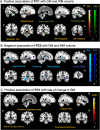Different inflammatory signatures based on CSF biomarkers relate to preserved or diminished brain structure and cognition
- PMID: 38216727
- PMCID: PMC11176056
- DOI: 10.1038/s41380-023-02387-3
Different inflammatory signatures based on CSF biomarkers relate to preserved or diminished brain structure and cognition
Abstract
Neuroinflammation is a hallmark of Alzheimer's disease (AD) and both positive and negative associations of individual inflammation-related markers with brain structure and cognitive function have been described. We aimed to identify inflammatory signatures of CSF immune-related markers that relate to changes of brain structure and cognition across the clinical spectrum ranging from normal aging to AD. A panel of 16 inflammatory markers, Aβ42/40 and p-tau181 were measured in CSF at baseline in the DZNE DELCODE cohort (n = 295); a longitudinal observational study focusing on at-risk stages of AD. Volumetric maps of gray and white matter (GM/WM; n = 261) and white matter hyperintensities (WMHs, n = 249) were derived from baseline MRIs. Cognitive decline (n = 204) and the rate of change in GM volume was measured in subjects with at least 3 visits (n = 175). A principal component analysis on the CSF markers revealed four inflammatory components (PCs). Of these, the first component PC1 (highly loading on sTyro3, sAXL, sTREM2, YKL-40, and C1q) was associated with older age and higher p-tau levels, but with less pathological Aβ when controlling for p-tau. PC2 (highly loading on CRP, IL-18, complement factor F/H and C4) was related to male gender, higher body mass index and greater vascular risk. PC1 levels, adjusted for AD markers, were related to higher GM and WM volumes, less WMHs, better baseline memory, and to slower atrophy rates in AD-related areas and less cognitive decline. In contrast, PC2 related to less GM and WM volumes and worse memory at baseline. Similar inflammatory signatures and associations were identified in the independent F.ACE cohort. Our data suggest that there are beneficial and detrimental signatures of inflammatory CSF biomarkers. While higher levels of TAM receptors (sTyro/sAXL) or sTREM2 might reflect a protective glia response to degeneration related to phagocytic clearance, other markers might rather reflect proinflammatory states that have detrimental impact on brain integrity.
© 2024. The Author(s).
Conflict of interest statement
The authors declare no competing interests.
Figures



References
Publication types
MeSH terms
Substances
Grants and funding
LinkOut - more resources
Full Text Sources
Medical
Research Materials
Miscellaneous

